#arab american national museum
Text
Meet the Arab Americans, whose heritage is a roadmap to education
Have you ever visited the Arab American National Museum or checked out their book awards, film festivals and concerts? The museum “provides people with a more authentic and real representation of what it means to be Arab American.”
“We communicate the American narrative in the voices of Arab Americans. They express their experiences in their own words,” says Diana Abouali, director of the Arab American National Museum, located in Dearborn, Michigan.
Arab immigrant stories aren’t well-known among mainstream America. And what little Americans do know about Arabs is often informed by negative stereotypes.
Arab Americans are a diverse community that come from 22 Arab countries stretching from northern Africa to western Asia. But once they settle in the U.S., the museum director says, they become as American as they are Arab.
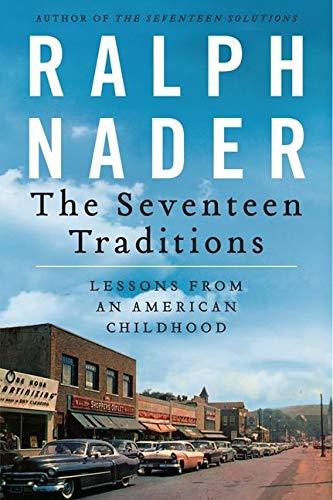
Ralph Nader is known for his lifetime of activism and fearless critique. Yet in this fresh and inspiring book The Seventeen Traditions: Lessons from an American Childhood, Nader takes a look backward - at a serene and enriching childhood spent in bucolic Winsted, Connecticut.
In his most personal writing to date, Nader fondly describes his father’s restaurant and how it taught him about work, community, how to share in the spirit of others, along with the value of his mother’s Lebanese cooking and how it defined his relationship with his heritage.
#manchester#iraq#iraqi#london#uk#baghdad#hussein al-alak#usa#arab americans#ralph nader#arab american national museum#america#dearborn#michigan#university of michigan#education#learning#higher education#schools#heritage#history#culture#women in history
5 notes
·
View notes
Text
"Gardening can help immigrant and refugee communities supplement their pantries by growing their own culturally appropriate food that isn’t found in grocery stores. Two community garden projects in Michigan create connections for those communities."
#PBS NewsHour#PBS#Community Gardens#Helping Refugees#Helping Immigrants#Al-Hadiqa (Arabic for “the garden”)#Garden Juju Collective#Cultivating New Beginnings#Cultivate & Grow Oral Histories project#ACCESS Hope House#Arab American National Museum
0 notes
Text
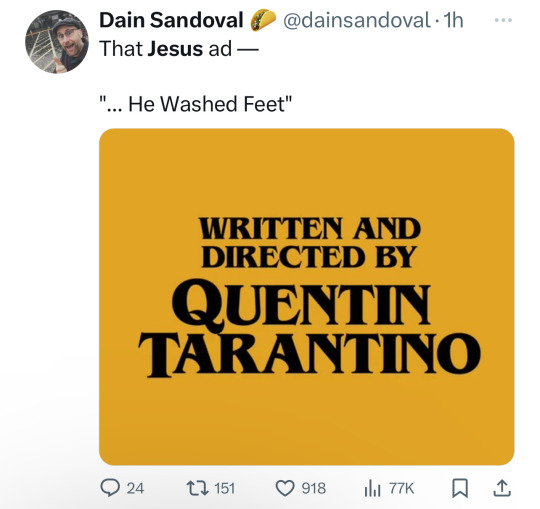





This is definitely a trend for the hateful, christofascist, religious reich. Hobby Lobby did the same thing at previous Super Bowls.


It’s right wing, Islamophobic, homophobic, anti-abortion Christian nationalism, masquerading as “caring” religion.

The Servant Foundation: the power behind the ads
The $20 million "He Gets Us" campaign about Jesus - is funded by an influential donor to some of the most active and litigious Shadow Network groups working to undermine church-state separation.
The Servant Foundation
The Servant Foundation, also known as The Signatry, is behind the “He Gets Us” ad campaign that debuted during the 2023 Super Bowl. Over the next three years, the Servant Foundation plans to spend “about a billion dollars” toward this public relations campaign. They’ve hired a PR firm to address, in the firm’s words, the problem of “How did the world’s greatest love story in Jesus become known as a hate group?”
Of course, they’re the cause of their own problem – not only has the Servant Foundation funded hate groups, but the PR firm, Haven, has represented these organizations. Key Shadow Network members Focus on the Family and Alliance Defending Freedom are in their portfolio. ADF is a noted anti-LGBTQ hate group that has argued repeatedly in courts that religion, and specifically Christianity, is a license to discriminate; they have one such case pending before the Supreme Court right now.
The money trail
The Servant Foundation is one of ADF’s biggest financial backers. A recent exposé reports that, “between 2018-20, the Servant Foundation donated more than $50 million to the Alliance Defending Freedom and that those contributions “were among the five largest donations given out by the foundation in each of those three years.”
Other recipients of the Servant Foundation’s billion dollars in assets include:
Nearly $8 million went to Answers in Genesis, creationist Ken Ham’s fundamentalist ministry behind the Creation Museum and Ark Encounter, an organization that has been championed by Speaker of the House Mike Johnson, a former ADF attorney.
Over $1 million was designated for the anti-LGBTQ Campus Crusade for Christ (rebranded as “Cru” since 2011).
$374,800 went to Al Hayat Ministries, an organization that seeks to “respectfully yet fearlessly unveil the deception of Islam,” and runs an Arabic-language Christian satellite TV station with the goal of converting Muslims to Christianity.
In 2020 alone, we found donations to prominent Shadow Network members American Center for Law and Justice, First Liberty Institute, and Liberty Counsel.
(continue reading)
#politics#super bowl#republicans#christian nationalism#lgbt#homophobia#christofascism#religious reich#lgbtq#jesus gets us#the servant foundation#no hate like christian love#the signatry#alliance defending freedom#adf
184 notes
·
View notes
Note
Hello! rly appreciating your posts, in particular the ones about GLAM... it made me curious if you or your followers happen to have any resources/literature to recommend on 2 areas of interest?:
1. Relating salvage anthropology to modern day ideas of trauma porn
2. Palestinian-led museums/archives/oral history projects/other collections or exhibitions of note. (Or if not literature, any names involved besides the few I know of like POHA/the nakba archive/the arab resource center for popular arts; the palestine museum; librarians & archivists with Palestine; activestills; forever our land; and art for gaza)
Anyway, again, thanks for all the time/work you’re putting into analysis and info dissemination <3
hello, thanks for sending this in. sooo i have like. no idea about the first one haha but i have so many for the second one.
The Institute for Palestine Studies has a bunch of scholarly articles and anaylsis about Palestine
Librarians and Archivists for Palestine is not completely Palestinian led but it's one that I'm a part of and really like, even though you already mention it.
The Palestine Museum Digital Archive is an AMAZING resource led by Palestinians in Palestine. I recommend scrolling through their intifada posters, downloading them, printing them, and hanging them around town.
The Palestinian Oral History Archive project in case people were wondering what POHA is.
The Museum of the Palestinian People in DC is really great and has a lot of digitized features.
The Palestine Museum US has a lot of books as well, based on Turtle Island.
The Arab American National Museum is not Palestinian led but I can vouch that they're a great group.
The Met has a lot of Palestinian clothing BUT.... warning in that it is very colonial in its arrangement and description and we dont super know how people got the material they have. If you want to look at the content feel free, though. Will say that Wafa Ghnaim, one of the leading experts on Tatreez in Turtle Island is working on recataloguing the Palestinian collection.
Visualizing Palestine is an infographic organization that might interest you.
The Nakba Archive for people wanting to check it out.
The Library of Congress is. Honestly it's pretty racist but it does have content if you wanna look at it.
Tirazain is a tatreez pattern library that's really cool.
There might be more that I'm forgetting but here are some just from me sitting here thinking for the past few minutes. If anyone else has any recommendations, feel free to add.
223 notes
·
View notes
Text
on western artistic chauvinism and islam.
As an American non-Muslim, i first learned about Islamic art and architecture in an academic context, when i was studying art history in college. one of the first things we studied was the complex geometric forms in islamic architecture. Some of the most striking, complex, and beautiful patterns in contemporary and historical islamic architecture are present in religious architecture.
Examples:
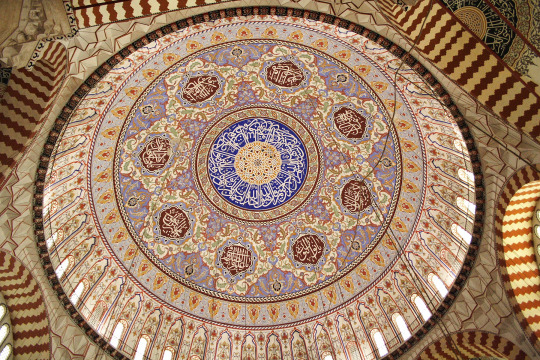
Dome of the Selimiye mosque, Turkey, completed 1574 CE.
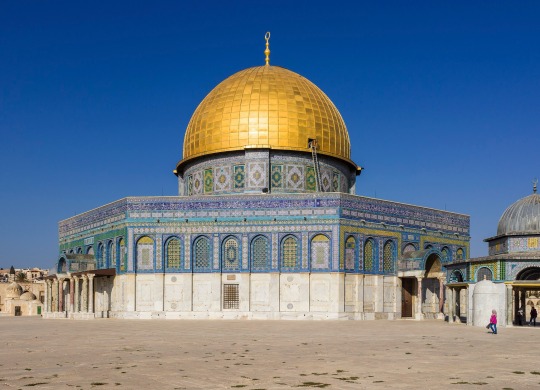

Exterior of the Dome of the Rock, a shrine withing the Al-Aqsa Mosque, Jerusalem, Palestine. Original construction was completed between 688 and 692 CE, and many alterations and repairs have been undertaken subsequently.
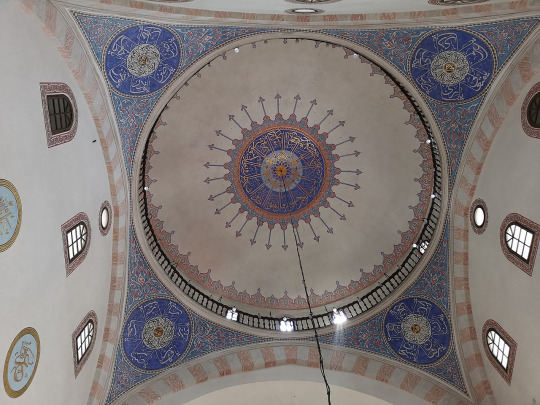
Dome of the Gazi Husri-beg Mosque, Sarajevo, Bosnia and Herzegovina, constructed 1531 CE. (Fun fact: In 1898 this mosque became the first known mosque in the world to have electrical lighting installed!)
The origins of these incredibly complex patterns partly stem from the avoidance of art depicting living beings according to religious principles, also known as aniconism, which is not universal throughout Islamic historical art, but gradually became nearly universal, especially in religious art an architecture. However, there are historical examples of secular figural art made by Muslims. (Link to an article on Islamic figural art by the Met Museum.) The Arab world in general maintained in-depth studies of mathematics and geometry throughout what we may call the "medieval" era in Europe. Arabic translations of Aristotle were studied. Al-Khwarizmi invented Algebra in 830 CE.
So, as any good artist knows, within a "limitation," artistic techniques can become more specialized and refined. Indeed, Muslim artists as far back as the Ummayad caliphate had extemely sophisticated application of geometry within their designs.
In art class I studied some of the fundamentals of how to construct similar geometrically repeating patters. I grasped the fundamentals quickly, and I found it enjoyable to work within these structures. However, as you increase the complexity, the degree to which you need to understand geometry to get your patterns to work out seemingly increases exponentially.
If you want a step-by step study of some of these geometric patterns, please check out the tutorials of the Lebanese artist Joumana Medlej. She also has tutorials on figure drawing and Arabic calligraphy.
(Speaking of calligraphy, I wanted to add more to this piece regarding calligraphy and architecture, but I feel I'm getting really long already.)
Years later, after I was finished with school, I got the opportunity to go to the Balkans. While I was in Bosnia & Herzegovina, I visited several historical mosques and got to see in person the type of art that I had previously only seen in photographs.
But what does it mean to acknowledge that this art exists?
Well, the mere acknowledgement and knowledge of the history of Islamic art, architecture, calligraphy, indeed, all the elements of distinct cultural heritage across the world, are controversial in the West.
One of the darkest examples of European violence against Muslim peoples was the Bosnian Genocide in the 1990s. This genocide did not start or end with the infamous massacre of ~8000 Bosniak Muslim men and boys by the Army of Republika Srpska (VRS) at Srebrenica, but also included systematic relocation of civilians, smaller massacres, and destruction of cultural heritage throughout Bosnia by both VRS and the Croatian Defense Council (HVO). Over one thousand mosques were destroyed. The VRS and the HVO both deliberately attempted to create "ethnically pure" Muslim-free statelets, and destroyed all the mosques in the territory that they held. The VRS burned down Sarajevo's National Library. The HVO blew up the Old Bridge of Mostar, a beautiful stone bridge in the middle of the city that had stood since the 16th century. (After the war, the stones were recovered from the river below and the bridge was reconstructed, and is used by Mostar residents every day.)
Israel refuses to acknowledge the historical and contemporary fact of the existence of a Palestinian people. As of February 2024, Israel has destroyed over one thousand mosques in the course of its bombardment of Gaza.
Many state and non-state actors within the U.S. and its allies also harbor these dark ideas of "bombing Muslims into the Stone Age." The invasion of Iraq was referred to as a "crusade" by President George W. Bush, and this attitude was aped by the Christian right wing in the USA.
All "they" see is a mythical horde from the East that must be destroyed.
But there is no horde. The people you share this earth with are your neighbors, regardless of their religion.
We live in a global society, and art anywhere is part of global cultural heritage. The acknowledgement, preservation, and study of Islamic art and architecture does not only culturally enrich Muslims, it enriches the whole world. Conversely, when you destroy Islamic art and architecture to harm Muslims, you also harm the rest of the world.
64 notes
·
View notes
Text
palestinian poets: george abraham
george abraham (they/he/هو) is a palestinian american poet, performance arist, and writer who was born and raised on unceded timucuan lands (jacksonville, FL). their debut poetry collection birthright (button poetry) won the arab american book award and the big other book award, and was a lambda literary award finalist. he is also the author of the chapbooks al youm and the specimen's apology. their collaborations include co-editing a palestinian poetry anthology with noor hindi (haymarket books, 2025), and a performance art project titled EVE with fargo nissim tbakhi.
they are a recipient of fellowships from kundiman, the arab american national museum, the boston foundation, the national performance network, and the MAP fund, and more. their writing has appeared in poetry magazine, the nation, the american poetry review, guernica, the baffler, the paris review, mizna, and many other journals and anthologies. a graduate of swarthmore college and harvard university, they have taught at emerson college, and are currently a litowitz MFA+MA candidate in poetry at northwestern university. he is also currently executive editor of the whiting award-winning journal mizna.
you can follow them on twitter @IntifadaBatata.
IF YOU READ JUST ONE POEM BY GEORGE ABRAHAM, MAKE IT THIS ONE
OTHER POEMS ONLINE THAT I LOVE BY GEORGE ABRAHAM
Field Notes on Terror & Beginnings at poetry daily
Love Letter to the Eve of the End of the World at the margins
Of Nation, at rusted radishes: beirut literary and art journal
Searching for a Palestinian After at the nation
Stage Directions for a Representation in which Eve and Adam travel through their first checkpoint at mosaic theatre company
the ghosts of the dead sea are rising at the drift
ars poetica in which every pronoun is FREE PALESTINE at the margins
“from UNIVERSAL THEORY IN WHICH EVERY FAILED ATTEMPT AT LOVE IS A SOULMATE FROM AN ALTERNATE TIMELINE” at fiyah literary magazine
Ode to My Swollen, Mono-Infected Spleen at brooklyn poets
The Olive Tree Speaks of Deforestation to my body at crabfat magazine
arab/queer vs. Imaginary at shade literary arts
self-portrait with second-degree sunburn at
[ summer / winter ] is the worst time to lose a [ country / lover ] at wildness
maqam of moonlight, for the wandering at the rumpus
against perturbation at the scores
apology, at cordite poetry review
i also adore this 2021 essay of abraham's at guernica magazine called teaching poetry in the palestinian apocalypse: towards a collective, lyric "i".
49 notes
·
View notes
Text
Books about colonialism now that The Queen is dead:
Colonialism is, unsurprisingly, A BIG FUCKING SUBJECT, and any reading list is going to fall short. (if you want to get versed in anti-colonial theory, here’s a really good beginners list). Because of all this, I’m staying focused on British imperialism, and specifically, events that happened within The Queen’s lifetime.
Legacy of Violence: A History of the British Empire by Caroline Elkins
Ghosts of the Empire: Britain’s Legacies in the Modern World by Kwasi Kwarteng
The Blood Never Dried: A People's History of the British Empire by John Neswinger
Ornamentalism: How the British Saw Their Empire by David Cannadine
The Decline and Fall of the British Empire by Piers Brendan
Insurgent Empire: Anticolonial Resistance and British Dissent by Priyamvada Gopal
Empireland: How Imperialism has Shaped Modern Britain by Sathnam Sanghera.
The Brutish Museums: The Benin Bronzes, Colonial Violence, and Cultural Restitution by Dan Hicks
Rhodes Must Fall: The Struggle to Decolonize the Racist Heart of Empire by Brian Kwoba, Roseanne Chantiluke, and Anthinangamso Nkopo
Neo-Colonialism: The Last Stage of Imperialism by Kwame Nkrumah
Kohinoor: The Story of the World’s Most Infamous Diamond by William Dalrymple and Anita Anand
Mountbatten: Apprentice Warlord by Adrian Smith
The Great Partition: The Making of India and Pakistan by Yasmin Khan
Midnight’s Furies: The Deadly Legacy of India’s Partition by Nisid Hajari
Partition, podcast by Neha Aziz
Aboriginal Australians: A History Since 1788 by Richard Broome
Ka Whawhai Tonu Matou: Struggle Without End by by Ranginui Walker
The Hundred Years’ War on Palestine: A History of Settler Colonialism and Resistance by Rashid Khalidi
Nasser: The Last Arab by Saïd K. Aburish
The Cyprus Emergency: The Divided Island 1955-1974 by Nicholas van der Bijl
Histories of the Hanged: The Dirty War in Kenya and The End of Empire by David Anderson
Imperial Reckoning: The Untold Story of Britain’s Gulag in Kenya by Caroline Elkins
Rhodesia: A Complete History, 1890-1980 by Peter Baxter
Massacre in Malaya: Exposing Britain’s My Lai by Christopher Hale
Kill the Indian, Save the Man: The Genocidal Impact of American Indian Residential Schools by Ward Churchill
A National Crime: The Canadian Government and The Residential School System from 1879 to 1996 by John S. Milloy
Missing and Murdered: Finding Cleo, podcast by Connie Walker
The Troubles: Ireland’s Ordeal and the Search for Peace by Tim Pat Coogan
Making Sense of The Troubles: The Story of Conflict in Northern Ireland by David McKittrick and David McVea
Say Nothing: A True Story of Murder and Memory in Northern Ireland by Patrick Radden Keefe
There Was A Country: A Personal History of Biafra by Chinua Achebe
The Untold Story of the Nigeria-Biafra War by Luke Nnaemeka Ameke
598 notes
·
View notes
Text
Playing Card Master Infodump
Ok gang, let's talk about playing cards again.
I’m going to try and get through this as systematically as possible but I will inevitably end up repeating myself due to the interconnected nature of the whole thing. Also I’ll try putting in subheadings to make it more readable. Let’s crack on!
Mameluk Playing Cards
I mentioned in my first post that European playing cards are based on ones from Mameluk Egypt, so let’s see if we can find some historical examples.

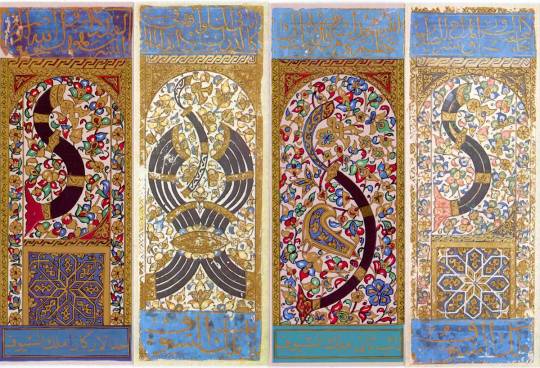
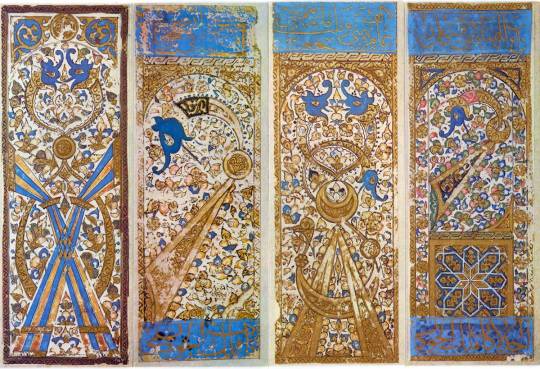

From the Topkapu Sarayi Museum in Istanbul, an amazingly preserved set of Mameluk playing cards depicting the four suits
These cards are a perfect starting point. Dating from the 15th or 16th century, we’ll be seeing their influence percolate throughout playing card design throughout Europe. Here we see the suits that will directly influence Spanish and Italian playing cards: coins, cups, swords, and polo batons (a common sport of the ruling class). The court cards are King-Lieutenant-Second Lieutenant, the deck would’ve contained 52 cards (1-10 plus three court cards), and the illustrations are rich in detail and heavy with Islamic calligraphy. We will be tracing the evolution of European cards back to these ones as we go along, so it’s important to have an example of where it all started.
Spanish Patterns
The Islamic influence in southern Spain makes it the perfect entry point for playing cards to arrive in European material culture around the late 14th century. Spanish patterns follow the same suits as Mameluk ones (coins, cups, swords, and staffs), but a deck would contain only 48 cards, numbers 1-9 and three court cards. The court cards follow the Mameluk rankings but with a European twist, making it King-Knight-Page. Swords in Spanish cards are depicted straight, as opposed to Italian swords which are curved.

Old Catalan / Spanish National Pattern, modern day

Piacentine Pattern, found in Italy in Bourbon ruled Piacenza, shows remarked Spanish influence yet is the only Spanish pattern regularly sold today to feature reversible court cards
Some syncretism would occur with the intermediary Franco-Spanish pattern, as Spanish cards would arrive in France prior to the establishment of the French standard patterns. The use of Spanish suited cards continues in areas such as Brittany and the Vendee through the game of Aluette, however the original Franco-Spanish pattern is now extinct. These decks would also consist of 48 cards: 1-9 and three court cards, King-Knight-Page (Roi-Cavalier-Valet). The use of these patterns would directly influence French patterns to come
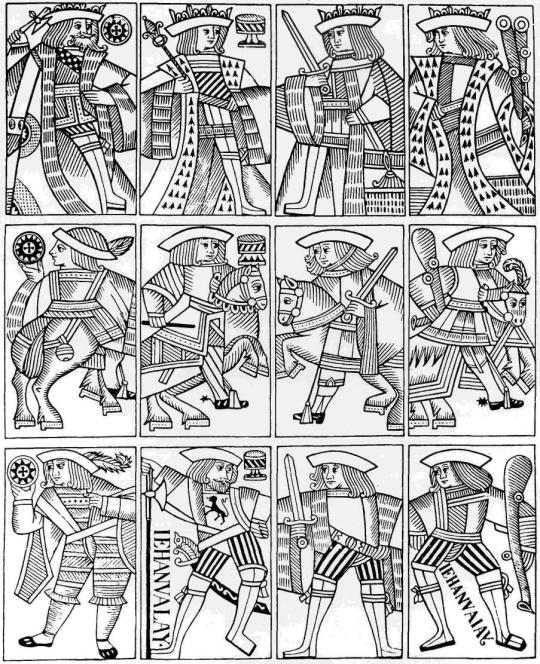
The court cards in the Franco-Spanish pattern showing Spanish suits
French Patterns
French patterns would begin with Spanish ones around the 14th Century, and would mesh with Germanic ones to produce something we would start to recognise as the Anglo-American pattern. The French suits (Hearts, Clovers (Clubs), Tiles (Diamonds), and Pikes (Spades)) are based on the Germanic suits (Hearts, Acorns, Bells, and Leaves respectively), however for a brief period a suit of Crescents was used instead of Tiles.
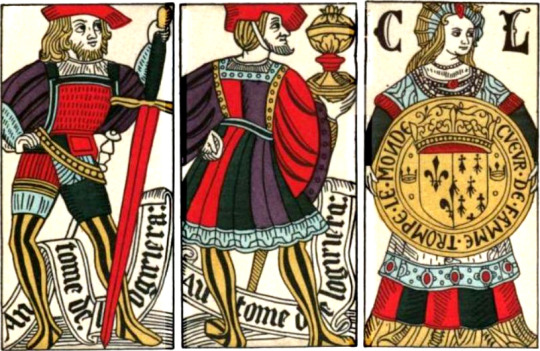
Cards celebrating the union of the kingdoms of Britanny and France, 1500, show the Spanish suits
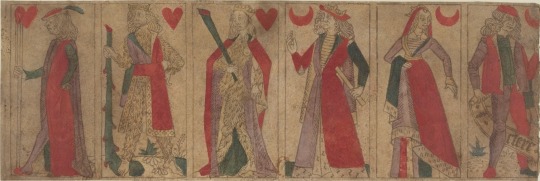
An example of the short-lived Crescents suit, Lyon, late 15th century
The majority of Italian, Spanish, and Germanic patterns follow the Mameluk tradition of all male court cards, which causes French patterns to stand out with the inclusion of Queens in place of the Knights. Queens had appeared in decks in both Italy and Germany in the 15th century, but had mostly been dropped in non-tarot decks. The inclusion of Queens, however, continued in France where their inclusion replaced the Cavalier (Knight) with the Dame (Queen). The naming convention of Dame for Queen will also be seen in Germanic patterns.
The Paris pattern, as distinct from Anglo-American or Hamburg patterns (about which more anon), is unique in that each of the court cards reference a historical or biblical figure, and are so named even to this day in the portrait officiel pattern (a deck of 32 cards, however sometimes printed in 52-card deck variants). As an example, the Kings of the Paris pattern refer to Charlemagne (Hearts), Alexander the Great (Clovers), Julius Caesar (Tiles), and King David (Pikes). The use of Julius Caesar as the historical figure associated with the King of Tiles, and most known in the past by his depiction on Roman coins in profile, might explain why in the later Anglo-American pattern the King of Diamonds is the only King to be depicted standing in profile.
Belgian pattern cards are similar to Paris (portrait officiel) decks and likewise come in 32-card and 52 card variants.
Germanic patterns
The closest pattern to connect Germanic decks to French ones is the Hamburg pattern, which would directly influence the North German or Berlin pattern. Taking the suits that we know today (hearts, clubs, diamonds, spades) and beginning production in the early 19th century, a clear link to the Paris (portraits officiel) pattern is shown in the depiction of the King of Spades holding the Harp of King David, a reference to the association of King David with the suit of Pikes (Spades) in the Paris pattern, and the laurel wreath under the crown of the King of Diamonds (Julius Caesar, King of Tiles). Germanic patterns closely associated with the French patterns name the court cards as King-Lady-Farmer (König-Dame-Bauer)
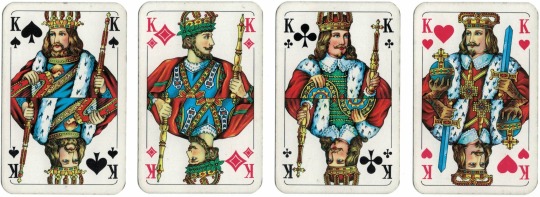
The Kings from the North German pattern showing links to the Paris (portrait officiel) pattern conventions
Germanic pattern playing cards, however also predate the suits used in French patterns and had a direct influence on them. The Germanic suits of Hearts, Acorns, Bells, and Leaves became standard around 1450, where upon it would directly influence the French suits and finally the modern Anglo-American system of Hearts, Clubs, Diamonds, and Spades. Many packs using this system contain only 32 or 36 cards, as is appropriate for the kinds of games played in the areas where they are common, and the court cards are typical established as King-Over-Under (König-Ober Knabe-Unter Knabe) in the Mameluk style of a leader and two ranks of soldier. The Ace in Germanic suits is really, and was referred to in the past as, a Deuce (Daus in German), which is why the Ace in these decks, the highest card in many regional games, actually exhibits two suit symbols rather than one. In the William Tell pattern deck, the four Deuces represent the four seasons of the year, however this is not typical across Germanic decks, which typically depicted a boar or sow in older decks, a tradition that continues today only on the Deuce of Bells.
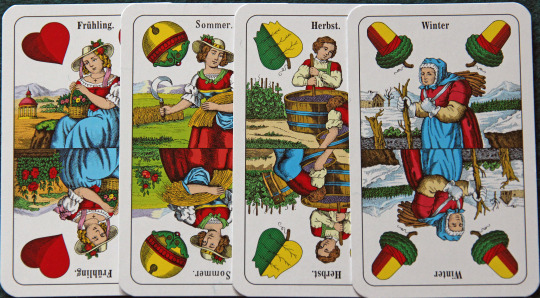
The Deuces (Daus) of Germanic decks
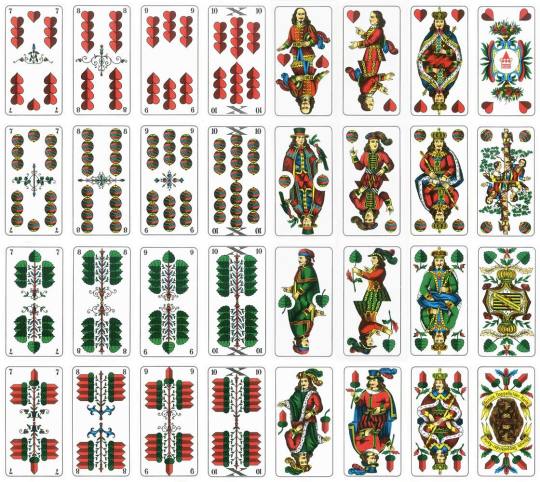
Saxon pattern

Polish-Silesian pattern for the game of Skat

Altenburg Doppelkopf pattern, exhibiting the North German pattern court cards of König-Dame-Bauer with the Germanic suits

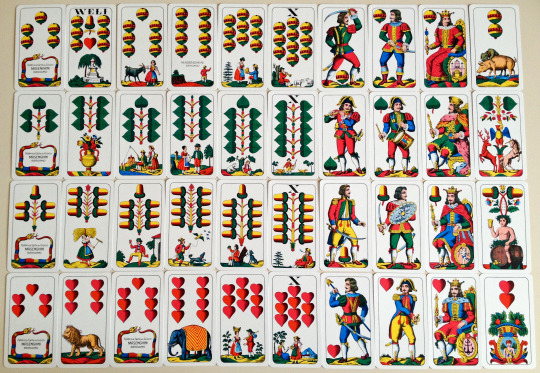
Salzburg pattern showing non-reversible court cards typical of earlier patterns, and Franconian pattern showing reversible ones, typical of later patterns
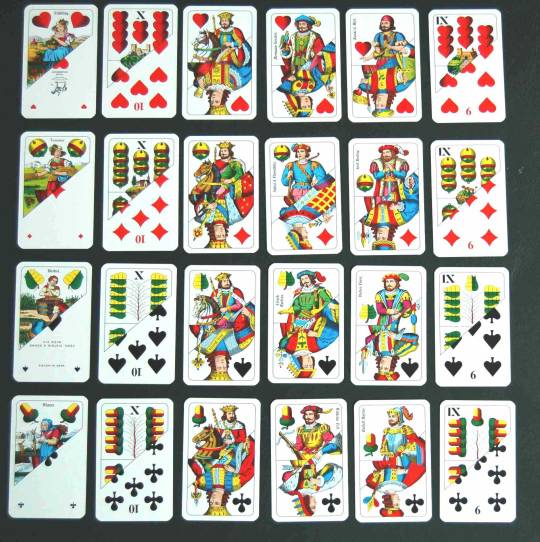
A hybrid deck showing both Germanic and French suits, in this instance the Germanic pattern is listed as William Tell and the French as Viennese
Italian patterns
Italian patterns closely resemble Mameluk and Spanish patterns, and it is in Italy where the polo baton of the Mameluk deck was replaced with a staff, or baton or club, for an area where polo was not well known or played.
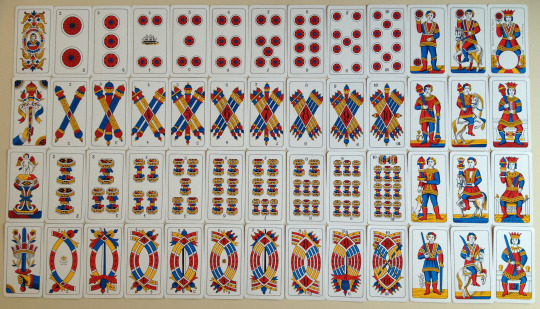
Trentine pattern, showing the Mameluk influence in both suits and court cards (King-Knight-Page)
In South Tyrol, a region acquired by Italy at the First World War, the Germanic Salzburg pattern is still used with Italian translations known as the Salisburghesi pattern.
It was in Italy that the first tarot decks were produced, where additional ‚trumps‘, known in Italian as trinofi, were added for more advanced card games. Typical to Northern Italy in the Italian suits, tarot cards for games such as Tarrochi, Tarock, and Scarto spread to France and Germanic areas whereupon there was further alterations made.
Tarot patterns
Tarot cards were never originally intended for Cartomancy, such associations came later in the 18th and 19th centuries, however there is a distinct split between Franco-Italian patterns and Germanic ones. A rare Italian deck serving as a progenitor of sorts to later 78-card tarot decks that now lost, was described in a letter from Milan in 1449 and supposedly consisted of a deck of 60 cards with only the four Kings as court cards, sixteen trump cards, and the suits as birds rather than any surviving system. Early 78-card decks replaced the court cards with classical figures and made the trump cards those of classical deities. Many of these early decks survive only as incomplete examples, damaged printing sheets, or in descriptions alone.
The Tarot of Marseilles is likely the first 78-card tarot deck to resemble the one we know today. The suits follow the Italian and Spanish patterns, synthesises the French and Spanish-Italian-Mameluk courts cards to give four in each suit: King-Queen-Knight-Page. The Major Arcana, or the trumps when ranked by value, are similar to modern tarot decks, albeit with some notable differences: the Magician is replaced by Le Bateleur (The Juggler), the High Priestess by Le Pances (The Popess, likely a reference to the myth of Pope Joan), and the Hierophant with Le Pape (The Pope). In Swiss tarot decks, the High Priestess is replaced by the classical deity Juno, and the Hierophant with Jupiter, in the style of the older historical Tarot de Besançon pattern.
Germanic tarot cards, however, are entirely different in nature. Trump cards in the Bourgeois Tarot pattern, with its sub-pattern the Tarot Nouveau, depict scenes rather than figures, and are split into groups of four (such as the times of day and the four elements), with the final three depicting Games (trump 20), the Collective (trump 21), and the Individual (trump 1)

Example Tarot Nouveau trumps, reversible but each scene depicting the card’s meaning

The trumps of the Industrie und Glück pattern, a standard tarot deck for games in the Germanic regions that uses the French suit system for value and court cards
One variation of tarot decks, known as Animal Tarot patterns, uses both real and fictional animals for the trump cards, and continues today only in the south German Adler Cego pattern
The End?
Honestly, this is all I have energy for at the moment, but I wanted to show just a hint of the huge variety of different playing card designs throughout the centuries and their effect on the modern decks of today. There is so much more I’d like to get into, so if you have some questions please please please ask!
36 notes
·
View notes
Text
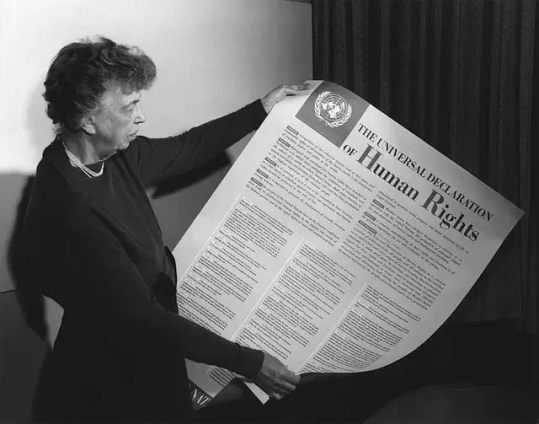
[Eleanor Roosevelt with the Universal Declaration of Human Rights, courtesy of the FDR Presidential Library & Museum, via Wikipedia Commons]
* * *
LETTERS FROM AN AMERICAN
December 10, 2023
HEATHER COX RICHARDSON
Seventy-five years ago today, on December 10, 1948, the United Nations General Assembly announced the Universal Declaration of Human Rights (UDHR).
At a time when the world was still reeling from the death and destruction of World War II, the Soviet Union was blockading Berlin, Italy and France were convulsed with communist-backed labor agitation, Arabs opposed the new state of Israel, communists and nationalists battled in China, and segregationists in the U.S. were forming their own political party to stop the government from protecting civil rights for Black Americans, the member countries of the United Nations nonetheless came together to adopt a landmark document: a common standard of fundamental rights for all human beings.
The United Nations itself was only three years old, having been formed in 1945 as a key part of an international order based on rules on which nations agreed, rather than the idea that might makes right, which had twice in just over twenty years brought wars that involved the globe. In early 1946 the United Nations Economic and Social Council organized a nine-person commission on human rights to set up the mission of a permanent Human Rights Commission. Unlike other U.N. commissions, though, the selection of its members would be based not on their national affiliations but on their personal merit.
President Harry S. Truman had appointed Eleanor Roosevelt, widow of former president Franklin Delano Roosevelt and much beloved defender of human rights in the United States, as a delegate to the United Nations. In turn, U.N. Secretary-General Trygve Lie from Norway put her on the commission to develop a plan for the formal human rights commission. That first commission, in turn, asked Roosevelt to take the chair.
“[T]he free peoples” and “all of the people liberated from slavery, put in you their confidence and their hope, so that everywhere the authority of these rights, respect of which is the essential condition of the dignity of the person, be respected,” a U.N. official told the commission at its first meeting on April 29, 1946. Their work would establish the United Nations as a centerpiece of the postwar rules-based international order.
The U.N. official noted that the commission must figure out how to define the violation of human rights not only internationally but also within a nation, and must suggest how to protect “the rights of man all over the world.” If a procedure for identifying and addressing violations “had existed a few years ago,” he said, “the human community would have been able to stop those who started the war at the moment when they were still weak and the world catastrophe would have been avoided.”
Drafted over the next two years, the final document began with a preamble explaining that a UDHR was necessary because “recognition of the inherent dignity and of the equal and inalienable rights of all members of the human family is the foundation of freedom, justice and peace in the world,” and because “disregard and contempt for human rights have resulted in barbarous acts which have outraged the conscience of mankind.” Because “the advent of a world in which human beings shall enjoy freedom of speech and belief and freedom from fear and want has been proclaimed as the highest aspiration of the common people,” the preamble said, “human rights should be protected by the rule of law.”
The thirty articles that followed established that “[a]ll human beings are born free and equal in dignity and rights…without distinction of any kind, such as race, colour, sex, language, religion, political or other opinion, national or social origin, property, birth or other status” and regardless “of the political, jurisdictional or international status of the country or territory to which a person belongs.”
Those rights included freedom from slavery, torture, degrading punishment, arbitrary arrest, exile, and “arbitrary interference with…privacy, family, home or correspondence, [and] attacks upon…honour and reputation.”
They included the right to equality before the law and to a fair trial, the right to travel both within a country and outside of it, the right to marry and to establish a family, the right to own property.
They included the “right to freedom of thought, conscience and religion,” “freedom of opinion and expression,” peaceful assembly, the right to participate in government, either “directly or through freely chosen representatives,” the right of equal access to public service. After all, the UDHR noted, the authority of government rests on the will of the people, “expressed in periodic and genuine elections which shall be by universal and equal suffrage.”
They included the right to choose how and where to work, the right to equal pay for equal work, the right to unionize, and the right to fair pay that ensures “an existence worthy of human dignity.”
They included “the right to a standard of living adequate for…health and well-being…, including food, clothing, housing and medical care and necessary social services, and the right to security in the event of unemployment, sickness, disability, widowhood, old age or other lack of livelihood in circumstances beyond [one’s] control.”
They included the right to free education that develops students fully and strengthens “respect for human rights and fundamental freedoms.” Education “shall promote understanding, tolerance and friendship among all nations, racial or religious groups, and shall further the activities of the United Nations for the maintenance of peace.”
They included the right to participate in art and science.
They included the right to live in the sort of society in which the rights and freedoms outlined in the UDHR could be realized. And, the document concluded, “Nothing in this Declaration may be interpreted as implying for any State, group or person any right to engage in any activity or to perform any act aimed at the destruction of any of the rights and freedoms set forth herein.”
Although eight countries abstained from the UDHR—six countries from the Soviet bloc, South Africa, and Saudi Arabia—no country voted against it, making the vote unanimous. The declaration was not a treaty and was not legally binding; it was a declaration of principles.
Since then, though, the UDHR has become the foundation of international human rights law. More than eighty international treaties and declarations, along with regional human rights conventions, domestic human rights bills, and constitutional provisions, make up a legally binding system to protect human rights. All of the members of the United Nations have ratified at least one of the major international human rights treaties, and four out of five have ratified four or more.
The UDHR is a vital part of the rules-based order that restrains leaders from human rights abuses, giving victims a language and a set of principles to condemn mistreatment, language and principles that were unimaginable before 1948.
But the UDHR remains aspirational. “As we look at the first 75 years of the UDHR,” Secretary of State Antony Blinken said today, “we recognize what we’ve accomplished in this time, but also know that much work remains. Too often, authorities fail to protect or—worse—trample on human rights and fundamental freedoms, often in the name of security or to maintain their grip on power. Whether arresting and wrongfully detaining journalists and dissidents, restricting an individual’s freedom of religion or belief, or committing atrocities and acts of genocide, violations and abuses of human rights undermine progress made in support of the UDHR. In the face of these actions, we must press for greater human rights protection and promote accountability whenever we see violations or abuses of human rights and fundamental freedoms.
“On its 75th anniversary, the UDHR must continue to be our guiding light as we strive to create the world in which we want to live. Its message is as importa
LETTERS FROM AN AMERICAN
HEATHER COX RICHARDSON
#Letters From An American#Heather Cox Richardson#United Nations#UDHR#Universal Declaration of Human Rights (UDHR)#history#human rights#Eleanor Roosevelt
18 notes
·
View notes
Note
hey dude. . . simple american here. can you tell us some cool awesome whimsical facts about Algeria? :))
OOOOOOOH ANON YOU JUST OPENED THE FLOODGATES
Algeria used to own the strongest navy ever known in the Mediterranean Sea, its power was so big that we used to have full control over the sea, nothing going in nor out without Algerian supervision
Similar to that, Algeria’s navy was so strong it used to tank European powers in battles, we even beat America in a war once
Algeria is full of diverse cultures and races, that includes Arabs, Kabyle, Tuareg, shaoui and much more
Following up to that, Algeria has the nickname of a “continent” given its very diverse landscapes and nature, it has seas and Sahara deserts, it has dunes and it has rock mountains, it has green mountains and green landscapes, it has rivers and it has ponds, it has snowy areas and it has hot areas, every corner of Algeria is like entering a whole new country, but infact you’re still in the same place
Algeria harbours one of the biggest open air museums in the whole world, aka “the Tassili”, which is a Sahara desert area located in the south of Algeria, mostly in the city of Djanet, it is full of beautiful rocks and cave painting that date to thousands of years back
Following up to that, the tassili harbours the oldest rock city “Sefar” that is full of paintings and artefacts that is said to represent tha oldest civilisation in the world
Algeria’s national animal is the fennec fox! Silly lil guy
Algeria’s second president was the first man to ever speak Arabic in the United Nations without interpreting, this was at the times where Arabic was not assigned an official language in the UN
We have a full section in our national anthem that tells France to eat shit and die
Algeria works by a “treat everyone the same way they treat you” system
Algeria is the 10th largest country in the world
It was an Algerian man that put Arabic in computers for the first time ever
Back during the October wars with the Zionist entity Israel, America sold rigged weapons to Egypt, so Algeria was like “nah fuck that” and went into debt with USSR from the amounts of weapons we bought from them
Back when the earthquakes struck Türkiye, the neighbouring country Syria was also badly horribly affected by the same earthquakes, however no country dared to send aids because America put restrictions against it, Algeria’s response to that was “nah fuck you, I do whatever I want” then proceeded to be the first country to actually step in and send help to Syria as well
It was Algerian human frogs that cleared Egypt’s harbour’s from ocean mines and bombs after the war with the Zionist entity
Algerians take dignity seriously, it’s so serious that if you go to Algeria and offer someone a tip they’d actually be offended that you thought that they were helping you for the money
Algeria is famous for its nickname “the country of the million and a half martyr”, that name is derived from the fact that during our 7 year revolution against France, OVER, one million and a half of people were martyred
Following up from that, during the whole 132 years of occupation, it was actually over 5.6 million people that faced martyrdom, the 1.5 million are only the ones that were victim to the 7 year revolution
When Algerians didn’t have access to weapons they used to actually beat the weapons out of the French authorities
Arbi Ben M’hidi, a famous Algerian martyr and figure, was so brave and held into his beliefs so tightly to the point he earned the respect of a French general that was supervising him, not that we need his fucking respect
“What is taken by force is only returned by force” is a famous quote in Algeria that stems from the massacres of 8th of may 1945 where over 45.000 Algerian people were murdered in one day
Little Omar aka Omar yacef is a brave 13 year old boy that used to work for the FLN and as their messenger, he was very brave and is a huge figure in our country, may he rest in peace
Following up to that, Saadi yacef, Omar’s uncle, was one of the FLN heads in Algiers, he managed to live past the revolution and survived to play his own character in the movie about the Algerian revolution, “the battle of Algiers” movie, he also managed to live to the point of seeing a whole hospital be built in the name of his brave nephew in 2014
Algerians have a fuck around and find out mentality, due to all the humiliation we endured for 132 years, we refuse to take any shit any longer
An Algerian’s favourite question is “where are you from”
Algeria once upped the prices of gas so high for France because the president fucked around and had to find out, he had to come over all the way to Algeria to negotiate about this situation
Algerians also go by a “im getting myself out of this hole, I don’t need nobody” mentality, cause for years so many countries turned their backs on us, most notably the dark decade
The dark decade is a time period from 1991 to 2002, where a civil war broke out and terrorism was all around the country, due to that, all countries closed their borders with algeria and called us terrorists and all (except Libya god bless and save our brothers there) so we really didn’t receive any outside help with isis, we had to fight them off on our own, we clawed our way out of that hole ourselves
Similar to that, when extreme forest fire struck algeria a few years back, only few countries offered aid to the destroyed cities, it was Algeria’s own citizens from other cities that donated money, food, clothes etc etc to the affected cities, showcasing the solidarity between our people
Algeria actually had many major resistances before the 1st of November revolution, the most notable one being the emirates of Abdul kader, they really made France run for its money, tho they all failed due to them being separate and all of the resistances dying with their leaders (not all the leaders were killed but still, the resistances stopped when the leader was stopped)
Speaking of Amir Abdul kader, after his resistance was stopped, he was exiled to Syria, there he had managed to actually save the lives of so many Christian folk from murder despite him being a fully Muslim man
Algeria actually had a decent Jewish population, however when France came along they found a way to separate Muslims and jews by giving jews full citizenship while leaving Muslims to eat dust and be their slaves, so when Algerians gained independence they kicked out anyone with a French citizenship, which included the Algerian jews with the citizenship, that resulted in Algeria’s Jewish population to get smaller and smaller as most of them left with the French, leaving Algeria a country that’s 99% muslim
Algeria actually suggested to cut off all gas and petrol on America and Europe to the Arabs a few days ago as a way to peer pressure the west into calling for a ceasefire on Gaza, unfortunately some Arabs countries voted against it
These are the things I could name on the top of my head, hope you enjoyed this silly infodump
17 notes
·
View notes
Text

Meanwhile in American zionist clownland….
Ben Shapiro is a smooth-brained conservative pundit who sounds like Kermit the Frog and has spent his entire life trying to achieve peak stupidity. He's also a fanatical zionist, and justifies his unquestioning support for Israel with profound statements like: "Settlements rock! Israelis like to build - Arabs like to bomb crap and live in open sewage"….
In January 2024, after a high profile visit to the Auschwitz Memorial Museum with Elon Musk, he posted a video in which he said that Jews, Roma, Russian soldiers and homosexuals were killed there, but failed to mention the Polish victims.
Although Auschwitz-Birkenau eventually became an extermination centre in which nearly a million Jews were murdered, the Germans created the camp in 1940 initially for the purpose of interning Polish slavic prisoners, who made up the majority of the inmates until 1942.
According to the Auschwitz Memorial Museum, at least 1.1 million of the 1.3 million people who were deported to Auschwitz-Birkenau died there.
900,000 Jews were murdered in the gas chambers immediately on arrival at the camp.
Of the 400,000 people who were registered as inmates, more than 50% did not survive.
They included 100,000 Jews, 70,000 Polish slavs, 21,000 Roma, 14,000 Soviet POWs and more than 10,000 prisoners of other nationalities, who died as a result of executions, medical experiments, starvation, brutality and disease.
Nobody knows how many LGBT people were deported to Auschwitz or died there, but only a tiny number were sent to the camp specifically for being gay. It's known that at least 77 men with pink triangles were imprisoned in Auschwitz and some scholars speak of up to 140 prisoners persecuted for their sexual orientation.
During their visit, Musk and Shapiro laid a wreath at the reconstructed "wall of death" next to Block 11, where SS men shot several thousand people, nearly all of whom were ethnically Polish - both Auschwitz prisoners and people who had been sent to the camp specifically to be executed, mainly for resistance activities.
It's amazing how often the camp's second largest victim group get erased from Western historical memory, but at least Shapiro didn't refer to Auschwitz as a "Polish concentration camp"….
#ben shapiro#american idiot#elon musk#history#auschwitz#auschwitz-birkenau#concentration camp#german concentration camp#second world war#world war 2#germany#poland#polska#israel#palestine#historical revisionism#bad history takes#bad history take
4 notes
·
View notes
Text
“Iraq, you are in our hearts”

The Awafi Kitchen is where Arab and Jewish cuisine are one. They are part of the Iraqi Jewish community and are based in Boston, USA. All of their family were displaced from Iraq between 1950 and 1970. The following statement and photograph were posted on the Facebook page of the Awafi Kitchen, and was titled ‘Our Return to Iraq’.
“Last month, after five decades away, members of our family finally walked the streets in Baghdad, the city they once called home. Out of hundreds of us in diaspora across the world, we were the first in our family to set foot in Baghdad since our waves of displacement between the 50s and 70s.
The trip was every feeling all at once. Pure joy, gratitude, and reconnection, inextricable from the grief and pain of facing our decades of separation, and seeing much of our family’s hometown deeply changed.
Our whole lives we’ve dreamed of witnessing the beautiful Baghdad we have been painted in memories. We found beauty, but also bore witness to the impact of decades of war, the US occupation, and ongoing resource extraction, and how this has limited the place’s ability to thrive.
That being said, the people we met were incredible. We spent two weeks surrounded by an abundance of love and warmth everywhere we went. There's beautiful new realities rebuilding. Iraqis returning, Iraqis who have stayed through it all.
Tender moments of mutual curiosity and excitement: younger Iraqis eager to learn about the old Baghdad of our family’s youth, the lost Jewish history of the city, and in turn our family eager to learn what it’s like to live as an Iraqi in the contemporary world. And ultimately, as friends reminded us, we accomplished our goal: it was just about touching foot to earth, and that we did.
For any Iraqis considering returning like we did, know that you can count on us for advice or perspective. Don’t hesitate to reach out. And for Iraqis with a reluctance to return, for those who still cannot, we empathize with you. Iraq, you are in our hearts.”
#iraq#iraqi#baghdad#mosul#basra#boston#awafi kitchen#iraqi jews#jewish history#passover#easter#us news#manchester#london#Iraqis#arab american heritage month#arab american national museum#manchester jewish museum#travel#the middle east#synagogue#heritage#jewish heritage#remember baghdad#the wolf of baghdad
31 notes
·
View notes
Text



Political posters, circa. 1974-1975.
Poster 1: Military Solidarity between Cyprus and Palestine, 1975.
Arabic translation: “Militant solidarity between the Palestinian and Cypriot peoples”
Greek translation: “Fighting Solidarity of the Palestinian people to the Cypriot people”
Poster 2: “We do not forget the Cypriot people, victims of the American imperialism”
Poster 3: “Middle East - Chile - Cyprus,” satirical Poster that comments on US foreign policy and intervention.
Image sources and information provided by the Palestinian Poster Project Archives and the National Historical Museum of Greece.
#cyprus#cypriot#cyprus history#cypriot history#cypriot posters#history#anti imperialism#decolonization#unite cyprus#cypriot archive#cyprus archive#free palestine#palestine archive#palestine poster project
6 notes
·
View notes
Text
youtube
Israeli-American journalist Caroline Glick gives her take on the recent controversy concerning Yad Vashem director Dani Dayan. In this video, she explains the key role that Jerusalem Mufti Hajj- Amin al-Husseini played in the Nazi Holocaust and subsequently as a leader of the Palestinian national movement.
Caroline Glick points to Dani Dayan's refusal to hang a picture of al-Husseini meeting with Adolf Hitler in 1941 in the Yad Vashem museum, as he confirmed during an interview with Haaretz in 2022. This refusal, she argues, is political-- even though Dayan claimed he would not hang the picture because that request was political.
This is information that western pro-Palestinian self-described allies will never mention (nor will the mainstream media), as it exposes precisely why Palestinian terrorists and leaders (who are often one and the same) have consistently rejected peace in favour of war, even if their own people suffer as a result.
When you understand the depth of al-Husseini's hatred for the Jewish people (he condemned groups of European Jewish children to death by preventing them from being transferred to Mandatory Palestine) and the admiration with which he is held by subsequent Palestinian leaders, there's simply no way to heap the blame on Israel, or even the territorial dispute over the West Bank, for there being no Palestinian state. There's also simply no way to separate anti-Zionism from antisemitism either, once you understand why al-Husseini is revered to this day by Palestinian leaders and presumably many Palestinian civilians.
And, unfortunately for UN Special Rapporteur Francesca Albanese, there's no way to equate Arab suffering during the 1948 War with the Holocaust by claiming they are both defining events. The displacement of Arabs between 1947-1949 came as a direct result of the Arab desire to destroy the Jewish State and kill its citizens, and al-Husseini was one of those who urged that desire, which is precisely why he was supportive of Hitler's extermination plan in 1941.
There's also no way to accuse European Jews of colonialism, either. While al-Husseini was in Iraq, he incited a massacre of the Jews in Farhud in 1941, the very year Hitler planned his 'Final Solution'. Glick says that around 900 Iraqi Jews were murdered. Over the next few decades, over 800 000 Jews would be persecuted and violently expelled from Arab lands in plain violation of the Balfour Declaration. Many of those Jews naturally moved to Israel. This is why today, a slight majority of Israelis are descendants of Jewish exiles to neighbouring lands.
Holocaust education can only succeed if the whole truth is told. While we live in an age where people are constantly demanding that such-and-such a history be re-examined in light of modern views, it's strange to see the director of Yad Vashem conceal vital facts for fear of causing offence.
Glick says that Dayan isn't even a scholar of the Holocaust; it appears his appointment was political.
Perhaps it is time for Yad Vashem to find a director who will tell the truth without fear.
#holocaust#yad vashem#palestinian#hajj amin al-husseini#arab#hitler#nazi#nazism#nazi germany#1941#farhud#iraq#pogrom#history#israel#jewish news syndicate#inconvenient truth#jumblr#Youtube
7 notes
·
View notes
Text
Synagogue inaugurated in Abu Dhabi
The first synagogue to be built in the Gulf states was inaugurated recently as part of the Abrahamic Family House, which includes a church and a mosque. Visitors attending the ceremony in Abu Dhabi included UK Chief Rabbi Ephraim Mirvis and Bahrain politician Huda Nonoo. The Circuit reports:

Guests at the inaugural ceremony for the Moses Maimonides synagogue
The white-stoned mosque, church and synagogue anchoring the Abrahamic Family House, a monumental interfaith compound that was unveiled last week in the United Arab Emirates, will serve as a busy forum for promoting religious cooperation in the Middle East, its founders said.
The individual structures that make up the new complex, which was designed by the acclaimed Ghanian-British architect, Sir David Adjaye, are linked by a central exhibition space, public garden and conference center that will open to visitors on March 1. The project was inaugurated last Thursday in a twilight ceremony in the capital city of Abu Dhabi led by members of the UAE’s royal court and leaders of the three faiths.
“This will be a great convergence point for the world,” Rabbi Yehuda Sarna, the chief rabbi of the Jewish Community of the Emirates, said in a webcast address from the new synagogue’s podium on Friday. “It’s the kind of place where great religious leaders and great cultural leaders will come to be inspired,” he told members of the Association of Gulf Jewish Communities over Zoom.
Built in the new cultural district on Abu Dhabi’s Saadiyat Island across from the dome-covered Emirati branch of the Louvre museum, the prayer compound is visually striking: Its three cube structures are built with identical dimensions of 30 meters in height, width and depth, while distinguished by iconic design elements referring to each religion. Visible in the desert landscape from the island’s main road and lit up at night are giant posts beside each building that carry the symbols of a crescent, a cross and a menorah. Adjaye previously built the award-winning National Museum of African American History and Culture in Washington, D.C.
The UAE president, Sheikh Mohamed Bin Zayed, hailed the opening in a tweet, declaring the country’s strengthening commitment to religious tolerance.
Read article in full
16 notes
·
View notes
Photo
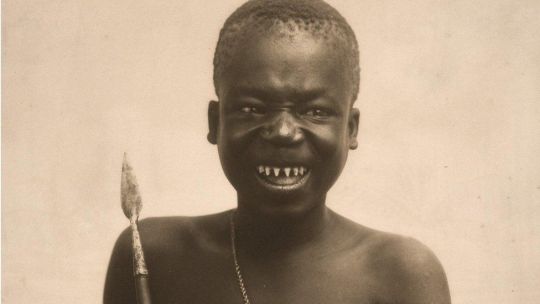
The Horrific Story of Ota Benga
Benga was born in the Ituri Forest, in the extreme northeast of the colony, to the Mbuti Pygmies. His people lived in loose bands of family groups of between 15 and 20 people, moving from one temporary village or camp to another as the seasons and hunting opportunities dictated. Benga married young and fathered two children, which put him on track to start his own family and perhaps someday lead a band himself, like the Mbuti had done for thousands of years.
But that wasn’t to be. Benga would never lead his own band.
When he was still a teenager, the eastern Congo erupted into a war that saw mass deportations, raids by Arab slavers, and an invasion by the Force Publique, a Belgian-led occupying army that was manned by the dregs of the colony and commanded by some of the worst sadists Belgium could produce; the Force Publique was originally formed to enforce rubber quotas and beat complainers with hippopotamus-hide whips.
Like many colonial militias, they were corrupt: they raped and murdered villagers, even collecting severed hands and heads. Sometime in the late 1890s, Force Publique “soldiers” found Benga’s family camp and killed his entire family. He was out hunting at the time, so he only got to see the aftermath of the massacre. To a hunter-gatherer like Benga, the family is life itself. Without them, he had the choice of wandering alone until he died, or seeking out a new family group and begging them to take him on as a helper.
However, aside from dying or finding a new family, fate tossed Benga a third option.
A short time after losing his family, he was picked up by slave traders who put him in chains and dragged him out of the forest, which had been the only home he had ever known. They put him to work as a laborer in an agricultural village. It was there, in 1904, that Benga was discovered by, of all people, an American businessman and amateur explorer named Samuel Verner.
Verner had been sent to the Congo on an expedition commissioned by the Louisiana Purchase Exposition, which was planning an exhibit for the St. Louis World’s Fair that would “educate” the public in what was then a racist, pseudoscientific brand of anthropology.
Verner’s job was to find some authentic African pygmies to display as “missing links” in human evolution. Looking at Benga, a lean, very black, very short man with teeth that had been filed into points, Verner knew he had what he needed. He bought Benga for a pound of salt and a bolt of cloth.
Verner’s group promptly brought Benga to St. Louis, where he was the hit of the 1904 World’s Fair.
He and the other captive Africans he had been lumped in with quickly figured out that the crowd wanted to see genuine African “savages,” so they started imitating the dancing and war-whoops they saw the nearby American Indians doing. He made friends with Geronimo and charged increasingly interested visitors five cents to see his teeth. At one point, the National Guard had to be called in to control the crowds because they were getting so large.
After the fair, Benga travelled with Verner and even returned to Africa for a time. In 1905, he took up residence with another Congolese tribe, the Batwa, and married a woman from the tribe. The marriage only lasted a few months, ending when Benga’s wife died from a snakebite. At loose ends again, Benga travelled back to the United States with Verner in 1906.
Upon returning to the United States in 1906, Benga’s first stop was a spare room at the American Museum of Natural History, where he again “delighted” visitors by pretending to be a babbling half-human. Everybody at the museum liked Benga, but the director refused to pay Verner the salary he was asking for, so eventually the pair picked up and moved to the Bronx Zoo.
Benga was allowed free movement through the zoo grounds, but his hammock was slung in the primate exhibit. He was displayed as part of the New York Anthropological Society’s exhibit on human evolution. Local black clergy were appalled by the exhibit and demanded Benga’s release, even lobbying the governor to force the zoo to shut down the display. Benga was eventually released into the custody of James Gordon, the minister who had led the charge to free him. He then went to live in Gordon’s black orphanage.
Still unhappy with his life, Benga eventually moved to Lynchburg, Virginia, to live with friends of Gordon named the McCrays. Gordon still managed Benga’s affairs, and he seemed to have definite ideas about how the 27-year-old man should live. Gordon arranged to have Benga’s teeth capped and enrolled him in a school for non-white children. He also got Benga a job at a local tobacco plant, where he seemed to have been popular and told his story for free root beer.
However, by 1914, Benga was planning a final return to Africa. Life in America, he decided, wasn’t for him. With the money he made from the tobacco job, Benga started putting things in order and looking for passage to the nearest port to his homeland. By this time, Leopold II was dead, and the Belgian government had stepped in to clean up some of the mess he’d left behind. Conditions were looking up in the Congo, and it was time to go home for good.
But this return passage was not to be. The outbreak of World War I suspended most cross-Atlantic shipping, and the German occupation of Belgium threw the Congo into bureaucratic chaos, with nobody allowed in or out. On March 20, 1916, depressed at the thought of not being able to return home, Ota Benga shot himself in the heart.
14 notes
·
View notes